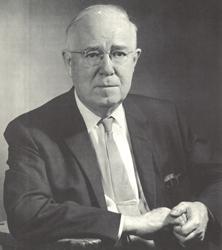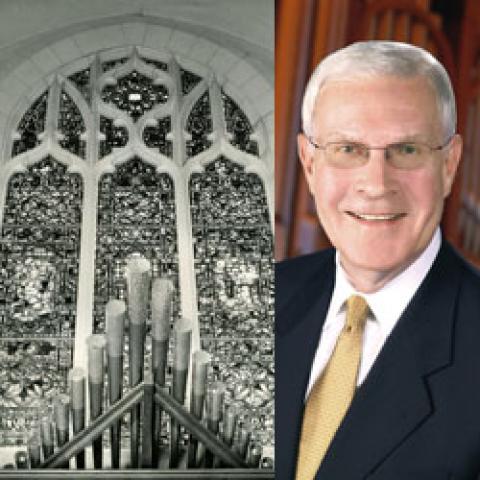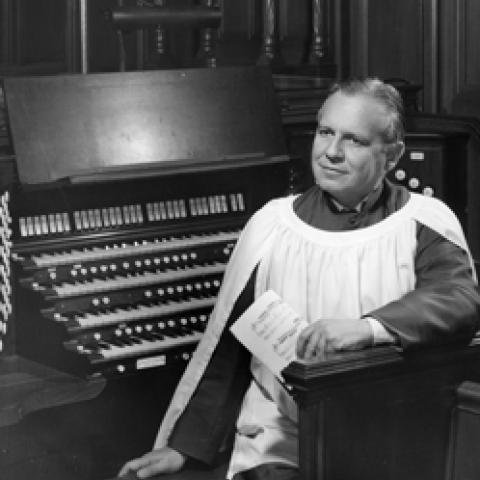A harpsichordist in Aeolian-Skinner land:
2012 East Texas Pipe Organ Festival
One recurring category in my performing career has been as a harpsichord soloist for conventions of organists: filling in when the planners wish to utilize an historic space in which the organ is not as interesting as the building (St. George’s Methodist Church, Philadelphia, for the International Congress of Organists, 1977); to showcase a lovely church in which the organ is not playable (New Orleans, Organ Historical Society, 1989); or to feature an orchestra hall bereft of any pipe organ whatsoever (Minneapolis, Twin Cities American Guild of Organists national convention, 1980).
Thus, an invitation to play harpsichord during the 2012 East Texas Pipe Organ Festival (November 12–15) was not a total novelty. The justly famous mid-20th-century Aeolian-Skinner organs in Kilgore and Longview were the primary focus for this second annual gathering of organ enthusiasts, but Kilgore’s First Presbyterian Church organist Lorenz Maycher, the originator and organizational wizard who put it all together and made it run smoothly for the 75 registered participants as well as large numbers of local concert attendees, decided that a quieter musical offering at mid-day on November 13 (my 74th birthday) might serve as a respite for “ears tired of too many mixtures.” While my program in Longview was ultimately scheduled for Trinity Episcopal, a church without an Aeolian-Skinner instrument, the parish’s three-manual organ by Fort Worth organbuilder Ross King was featured beforehand in a stellar morning recital by Jeremy Bruns, who demonstrated the organ and showed it to be a thoroughly satisfying and versatile musical instrument in a warm acoustical space.
Often the greatest obstacle to a successful harpsichord recital turns out to be the instrument on which it is played, so the decision was made to transport my own 1994 Richard Kingston Franco-Flemish harpsichord for the program. When asked if a concert would be expensive, I responded, “No, but moving my harpsichord will be!” Longview is 110 miles east of Dallas, an easy but time-consuming trek for my local instrument mover, himself a busy professional percussionist. Lorenz solved the transport problem by enlisting the aid of the Rader Funeral Home’s J Mitchell, who agreed to provide harpsichord moving. The Rader firm already had a history of supporting the local organ scene by moving large pipes during installation and recording projects. I was expecting that my nine-foot-long “Big Blue” would be transported in a hearse (reminiscent of at least two harpsichord deliveries from Willard Martin, who customarily bought used hearses, citing the ease of double parking them without penalty for deliveries “even in New York City”)! However, Mr. Mitchell substituted an unmarked white van and also provided its careful driver, Logan Montana, a student at Kilgore College.
Another necessity for a successful recital is the thoughtful choice of an appropriate program. How often have I attended a concert played for a general audience only to be underwhelmed by an overly esoteric choice of repertoire! For this particular outing, I figured that the audience would be appreciative and knowledgeable about organ music, but perhaps somewhat less familiar with the harpsichord offerings. Therefore I attempted to choose some works that might have at least a tenuous connection to the organ. After many draft programs were drawn up and discarded, I settled on one that included works by several composers likely to be known to the festival registrants. From J. S. Bach, two compositions to end each half of the recital: first, a transcription of his profound Chaconne in D Minor (from the Solo Violin Partita, BWV 1004) in an unpublished 1944 arrangement by the American harpsichord maker John Challis (who was also an organist), and, to conclude the concert, Bach’s shortest harpsichord Toccata (in E Minor, BWV 914), which opens with an ostinato figure suggestive of an organ pedal motive, includes a highly dramatic recitative, and ends with a brilliant chromatic fugue.
Additional composers probably familiar to organists included Herbert Howells (represented by three short dance movements from Lambert’s Clavichord) and Gerald Near, whose Triptych for Harpsichord I commissioned in 1982. This work, beginning with an atmospheric Carillon, proved site-appropriate, since the church’s hour chimes struck at two, providing thereby an unforeseen, but appropriate, introduction to the recital. To these works I added pieces that have been favorites in many of my concerts: Bohuslav Martinu’s Sonate pour Claveçin (1958), and two idiomatic baroque works: La D’Héricourt and La Lugeac by Claude-Bénigne Balbastre. Finally, a rarity newly added to my repertoire this season, Duke Ellington’s unique harpsichord work A Single Petal of a Rose (1965) in my own revision of an unpublished arrangement by Igor Kipnis and Dave Brubeck. It must have worked, for applause solicited an encore, Cantilena (from Trifles) by Texas-born, Denver-resident composer Glenn Spring.
The four-day festival sported a roster of players that easily might be the envy of most convention planners: evening recitalists included Ken Cowan (Rice University), Richard Elliott (Mormon Tabernacle, Salt Lake City), Thomas Murray (Yale University), and Bradley Welch (Highland Park Methodist Church, Dallas). In morning and afternoon programs the attendees heard organists Walt Strony, Jeremy Bruns, Ann Frohbieter, Charles Callahan, Christopher Houlihan, Scott Davis, and Christopher Jennings. A late evening showing of the silent film Phantom of the Opera featured organ accompaniment by Brett Valliant. Michael Barone, host of the nationally syndicated organ program Pipedreams, recorded all the concerts, and was a familiar and supportive presence throughout the festival.
A larger-than-expected number of registrants had indicated an arrival well before the official opening recital on Monday evening, so the resourceful Lorenz added a shopping tour of Kilgore antique and specialty stores, lunch, and an afternoon program at St. Luke’s United Methodist Church, during which Charles Callahan gave an effective brief improvisation in the form of a stop-by-stop demonstration of the church’s two-manual Aeolian-Skinner organ (1952) as a musical prelude to an informal conversation between the two of us on our assigned topic “Composers We Have Known.” Charles and I had not met previously, but we formed an instant camaraderie as we reminisced for more than an hour about associations with Leo Sowerby (and heard a recording of his anthem for SAB choir and organ, Jesu Bright and Morning Star), Gerald Near (with brief examples from his three-movement Concerto for Harpsichord and Strings), Daniel Pinkham, Thomas Matthews, Paul Creston, Alexander
Schreiner, Olivier Messiaen, Jean Langlais, George Thalben-Ball, Francis Jackson, Alec Wyton, Calvin Hampton, Herbert Howells, Vincent Persichetti, Ross Lee Finney . . . quite a diverse compilation of memorable luminaries!
Housing in the Comfort Suites at Kilgore was truly comfortable, with a full hot breakfast available each morning at no extra charge, a complimentary late afternoon happy hour (if one happened not to be at a recital), and an “even happier hour” that extended late into the night, where all could mingle to talk of the day’s events, enjoy a libation and snack, or purchase recordings, books, and music presented for sale by the festival artists. What better place could there be to acquire Callahan’s Kilgore Suite or reissues of historic Aeolian-Skinner organ recordings on compact discs produced by Lorenz Maycher’s Vermont Organ Academy?
The festival honored the life and work of Roy Perry (1906–1978), Aeolian-Skinner tonal finisher and Texas sales representative, a much-beloved musician and unforgettable character who served as organist of Kilgore’s First Presbyterian Church from 1932 until 1972. Perry is buried in the private Thompson Family Cemetery, a quiet and peaceful gravesite visited by the bus-travelling attendees on their way to a celebratory lakeside dinner in honor of the Crim family, donors of Aeolian-Skinner’s 1949 opus 1173 at First Presbyterian. Celebrated as well were the musical achievements of the Longview-born organist Alexander Boggs Ryan (1928–1978), who was remembered with a recital at First Baptist Church, Longview, featuring several works he had played there in 1959 on Aeolian-Skinner’s 1951 instrument (opus 1174), an exhibition at the Gregg County Historical Museum, and a gala reception.
It is this sense of connection, of place, and of gratitude to those whose gifts caused such treasured instruments to be built in these Texas churches that assures the festival’s success not only with those who come from afar, but also for the local residents who attend in generous numbers. All the musical programs are open to the general public at no charge, and it was especially gratifying to see many young people at these recitals, including students from the local college and a group of organ students from Appalachian State University in Boone, North Carolina, who had made the long trip to Texas in a van with their teacher Joby Bell.
It was an honor to be a part of this event, and I felt a great sense of anticipation when informed that my picture (in color) had been published in the Longview News-Journal for Wednesday, November 14. When the festival bus arrived back at the hotel late that evening, I set out on foot to find a copy of the paper, and, after two false attempts, actually found one! And there, at the bottom of page 6A was the photo with the caption, “Larry Palmer performs Tuesday on an autochord at Trinity Episcopal Church.” For years I have collected misspellings of the word harpsichord (and there are many of them that have appeared in print), but here was a totally unique attribution, only one of many pleasant experiences afforded by the East Texas Pipe Organ Festival, 2012.
For a more detailed account of this festival, see Neal Campbell’s report on pages 22–25 of this issue. For more information about past and future festivals, see www.EastTexasPipeOrganFestival.com. ν
Photo credit: Bill Leazer






